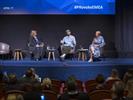Paul Holmes 11 Jan 2010 // 12:00AM GMT
Americans had more memorable experiences with fast food launches than with technology, toys or personal care products in 2009, according to the eighth annual Most Memorable New Product Launch Survey, conducted by Schneider Associates, IRI and Sentient Decision Science, following two years in which technology products have dominated the top ten.
This year, five quick service restaurant favorites reached the top spots: three of them considered “premium” offerings that fit into the “migration marketing” trend, which involves products encouraging consumers to “trade up” or “down” in a recessionary marketing environment.
While 93 percent of respondents could not name one new product launch from the list of 50, the majority who did—an overwhelming 40 percent—recalled KFC’s Grilled Chicken launch in April of 2009, which involved media maven and launch powerhouse Oprah Winfrey in a national, free grilled chicken promotion.
“2009 was the year of comfort food and small indulgences,” says Julie Hall, executive VP and partner at Schneider Associates. “This past year, real estate values plummeted, massive corporations failed, the stock market was in freefall, our government was managing bailouts, and there were continued job losses. The economy is improving now, but looking back, it’s no surprise people donned Snuggies and tried new and premium fast food offerings.”
Consumers were given a list of 50 new product launches from the past year, and most commonly remembered: Kentucky Grilled Chicken (40.1 percent); McDonald’s McCafé (29.6 percent); the Beatles: Rock Band video game (18.3 percent); Snuggie (17.7 percent); Blackberry Storm (13.2 percent); Quizno’s Torpedo (12.9 percent); McDonald’s Angus Deluxe (12.6 percent); Taco Bell Volcano Nachos (10.7 percent); T-Mobile Google G-1 Phone (7.3 percent); and the Samsung LED TVs (6.9 percent) and Off Clip-On (6.5 percent).
According to Aaron Reid, chief behavioral scientist at Sentient Decision Science: "One of the most remarkable findings of the research is the pervasiveness of being actively online while watching television. Furthermore, 85 percent of people who are online while watching television have searched for something they just saw, a significant shift in the information flow. The resulting social media conversation is substantially influential."
Other survey findings:
· Income loss is pervasive with nearly one-half of respondents (44 percent) experiencing a reduction. Contrary to traditional thinking, this group was more likely to purchase new technology and food products, and to be early adopters.
· People used five media sources for information about a product (six for 25-34 year-olds)
· Avoidance of commercials using a TiVo or DVR nearly doubled from 2008 (38 percent versus 22 percent) in a time when media outlets are declining.
· Women are significantly more likely than men to recommend new products to friends and family, and take recommendations (58.8 percent versus 45.3 percent, and 59.7 percent versus 47.3 percent). - MORE -
· Younger respondents (18-24) are more influenced by “environmentally friendly” attributes than other age groups (68 percent versus overall rating of 44 percent).
· Free samples (91.5 percent), recommendations from family and friends (81.2 percent), and coupons (71.6 percent) are the most influential sources of information for purchasing decisions, continuing a long running trend.
· Trusted brand names continue to be highly influential in affecting purchase (70 percent).
· Brand names are even more influential for retirement aged respondents (75 percent) and early adopters of technology products (78 percent).
· Most consumers surf the Web and watch television simultaneously (66 percent). Almost half (44 percent) do it very or extremely often. This group is also more likely to search for products seen in commercials (18 percent versus 11 percent overall).
· Twitter users see the medium as a highly influential source of information (56 percent). They are also more likely to visit a product Web site after viewing a commercial (44 percent); and they report watching significantly more news online than the overall group (73 percent versus 48 percent).
· Nearly everyone watches content online (80 percent), with the younger audience of 18-34 leading online content consumption (93 percent).


































.jpg)
















